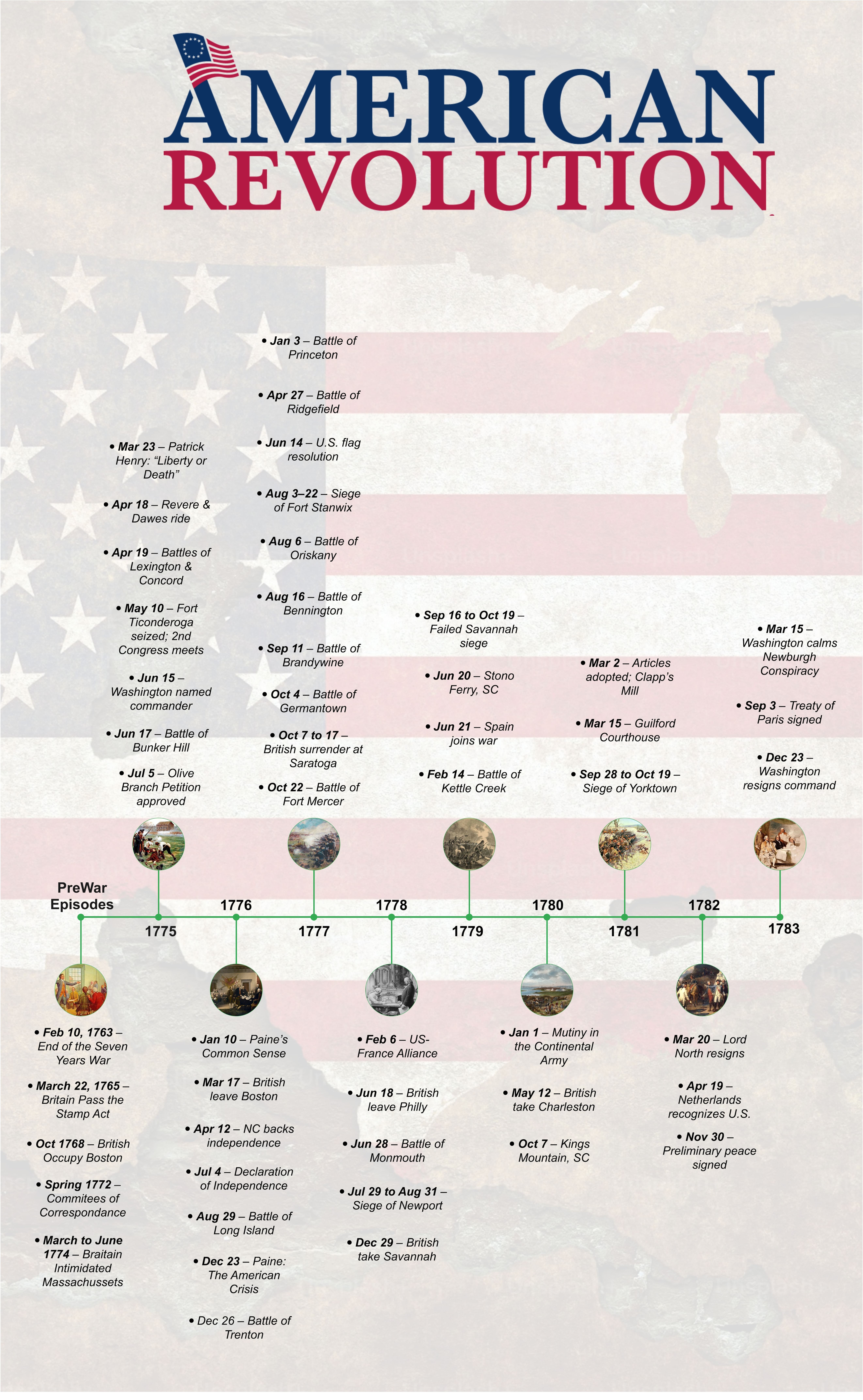Concluding their French and Indian Wars, Great Britain attempted to recover its massive defense expenses from its North American colonies. However, it did not settle well with the colonies, leading to a revolt that would last for eight years.
What happened during these years? What became the trigger of the declaration of war? From policy actions to battlefields, let’s understand everything with this easy-to-understand American Revolutionary timeline.
In this article
American Revolutionary War Timeline 1775 to 1783
Triggers of War: 1763 - 1774
In 1763, the Seven-Year War, also known as the Indian and French War, concluded with the Treaty of Paris. It left Britain with depleted reserves. The insecurity led the colonists to impose the new taxes on the Northern American territories.
To further cover the defense expenditure during the war, the British Parliament passed the Stamp Act in 1765. This would impose duties on legal documents, newspapers, etc. The colonies resisted this act, leaving the monarchy surprised.
In 1767, the British imposed a series of acts to force the colonies to comply with their demands, known as the Townshend Acts. The following year, the forces landed in Boston to enforce these duties, leading to multiple confrontations with the colonists.
Following these confrontations, the Boston Massacre happened in 1770. When a crowd of colonists threw the shells at soldiers, one soldier discharged the gun and killed five Americans.
In 1772, the British launched Committees of Correspondence throughout the colonies to enforce and regulate their laws. The broader purpose of these committees was to develop a national identity among the Americans.
1774 was all about the Intolerable Acts imposed by Britain. Under one such Quartering Act, Britain seized the Boston Port and required the colonies to house British soldiers. This was met with disapproval and created sympathy for Massachusetts.
1775
On March 23, 1775, Patrick Henry made his infamous speech amid the revolt: “Give me Liberty or Give me Death”. Delivered at Virginia’s Assembly, this passionate declaration talked about the rights of colonies.
The following month, on the 18th, Paul Revere travelled to Lexington to inform American revolutionaries about the British forces marching to Concord. This is also when he launched his popular signal lanterns.
What followed the next day was the Battle of Lexington and Concord on April 19. This marked the official beginning of the American Revolutionary War.
On May 10, the Mountain Boys, Benedict Arnold, and Ethan Allen captured Fort Ticonderoga to boost the morale of the revolutionary American forces.
However, eventually, a new army was formed on June 15 under the leadership of George Washington, popularly called the Continental Army.
The next event in the year 1775 was the Battle of Bunker Hill. On June 17, the revolutionaries had their first major engagement in Boston, which ended with British victory but with a great loss.
On July 5, the colonists sent a formal declaration to King George III, called the Olive Branch Petition. The British added it to the Second Continental Congress in an attempt to avoid the war and reaffirm the colonists’ loyalty to the crown.
1776
Aside from the battlefront, the war was also literary. On June 10, Thomas Paine published a pamphlet called Common Sense. It boosted the morale of the revolutionaries and turned the tide in favor of independence for the native Americans.
On March 17, given the massive chaos across America, British troops evacuated Boston. Washington’s Continental Army ended the stalemate by compelling General William to retreat.
The next month, on April 12, the Halifax Resolve at the North Carolina Provincial Congress declared total independence from Britain. This was the first full, formal independence declaration from the colonies.
After Virginia’s Fifth Revolutionary Convention declared independence from Britain in June, Congress issued the final text of the Declaration of Independence on July 4. All 13 colonies finally signed this document, severing all ties to Great Britain.
On August 29, the British won their first major battle after the declaration of independence. During the Battle of Long Island, Washington’s forces escaped across the East River.
Thomas Paine made a comeback in December with the pamphlet The American Crisis No. 1. It was so effective that the soldiers in the Continental Army added another year of service in their contracts.
In the following days, Washington crossed the Delaware River and launched an offensive at Trenton. This event was deemed successful for the Continental Army, as they declared their first major victory.
1777
In January, the Washington Army engaged in the Battle of Princeton with the British. Alexander Hamilton, the future Secretary of the Treasury and soldier at the time, and James Monroe, the future President, played a significant role in this battle.
On April 23, the British launched an offensive at Ridgefield against the Continental Army under Major General William Tryon. Ultimately, the crown won.
Meanwhile, on June 14, the flag resolution was held at the Second Continental Congress with the flag having the stripes and stars design arrangement.
In August, the Continental Army faced the General Barry St Leger forces. Eventually, this event led to the siege of Fort Stanwix.
While Fort Stanwix was besieged, the two forces also had another confrontation on August 6 at the Battle of Oriskany. During this battle, all the people on both sides were native Americans.
Another battle at Bennington also happened during this time when the British tried to seize the Washington Army’s supplies. But the battle ended with the victory of the Continental Army.
In September, the British launched another offensive at Philadelphia, called the Battle of Paoli. This event led to numerous American casualties.
Following this was the Battle of Germantown on October 4 to free Philadelphia.
In October, General John Burgoyne surrendered at the Battle of Saratoga under the Convention of Saratoga.
The last event of 1777 was the Battle of Fort Mercer. The battle was launched by the Hessian Britishers to take the Fort, but ended with them facing massive casualties.
1778
In February, France officially joined the American Revolutionary War against Britain. Later, France’s military and financial aid proved crucial in the Continental Army winning the war.
On June 18, the Philadelphia occupation ended after nine months when Sir Henry Clinton decided to retreat.
After ten days, on June 28, Charles Lee was replaced by George Washington due to an irrational and miscalculated order for the Battle of Manmouth. Though the Americans declared victory, the GB forces had already escaped to New York.
From late July to late August, the Americans and French besieged Newport’s Rhode Island. Eventually, they would withdraw these forces.
On December 29, the British attacked and defended Savannah, eventually claiming a victory.
1779
In February, the Americans led the Battle of Kettle Creek against the loyalists and ended with the death of Captain James Cook.
On June 20, both sides had another battle at Stono Ferry, South Carolina. It ended with the Patriots gaining a victory.
On the European front, Spain joined France against Britain and allied with the colonies in independence on June 21.
From September 16 to October 19, the American-French alliance struggled to retake Savannah but remained unsuccessful. During this episode, the Continental Army faced its deadliest defeat.
1780
On January 1, the currency sinking led the Continental Army to a short-lived mutiny.
Having consecutive wins in 1780, the British captured Charleston on May 12, along with four American ships.
On October 7, Benedict’s Kings Mountain defeated the loyalists.
1781
On March 2, the Articles of Confederation finally got ratified. These articles were originally passed by the Americans in 1777.
The British had another victory over the patriots on March 15 at Guildford courthouse, though they suffered heavy losses.
From September to October, the American-French forces kept the British trapped in Yorktown, leading to the surrender of General Cornwallis.
1782
Due to the opposition he faced in the parliament, Lord North resigned as Prime Minister on March 20.
After Morocco, the Netherlands became the second country to recognize the new Republic of America on April 19, 1782.
The British finally gave in, and both sides joined the preliminary articles of peace toward the independence of America.
1783
The mutiny in the Continental Army came back. On March 15, Washington visited the army officers’ assembly at Newburgh to address the distrust among the soldiers. This was quite effective in calming the revolt.
Finally, the American Revolution ended on September 3 with the Treaty of Paris. The new nation was named the United States.
On December 23, Washington resigned his commission, setting the precedent of civilians controlling the army in the USA.
How to Make a Similar American Revolutionary War Timeline Using EdrawMax?
This American Revolutionary War timeline has effectively organized the events throughout the nine complex years. Such an infographic is excellent at making it easier for the audience to understand the sequences and relationships between events.
Wondering how to make it? Try the timeline tool - EdrawMax. Its resizable symbols, editable text, and design tools simplify the creation process. Here is how it goes.
Step1Open the Timeline Canvas
- Visit the Home tab from the dashboard.
- Select Basic Diagram from the menu and click Timeline.
- Choose a desired format from the templates. Let’s use a blank canvas for this timeline.
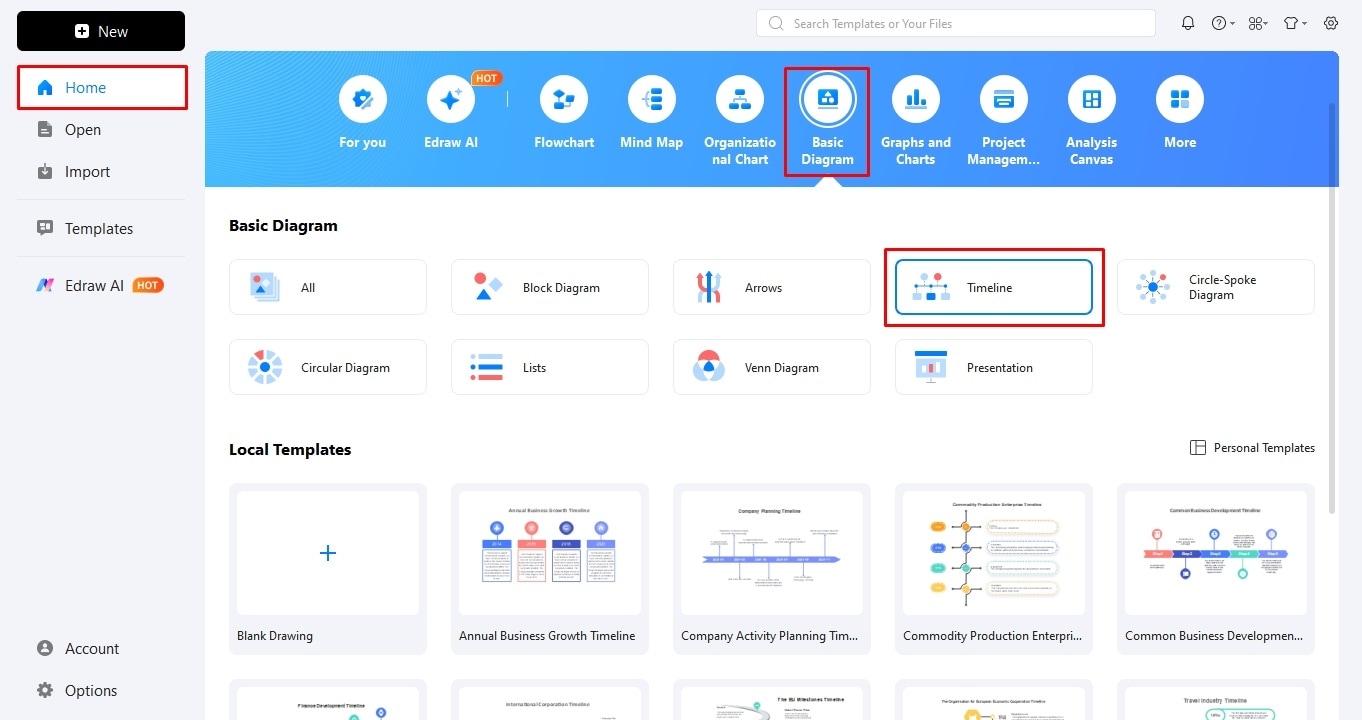
Step2Plot the Structure
- Once on the editing panel, the most important element is the structure. Simply put, it is a framework in which you will add your milestones and their descriptions.
- First, take your time to think about what layout better suits your data. For instance, the vertical layout complements the consecutive events throughout the years of the American Revolutionary War and leaves you space to add descriptions optimally.
- Once decided, locate the Symbol library from the left-side menu.
- Choose a desired framework under the Timeline section.
Drag and drop this shape onto the canvas.
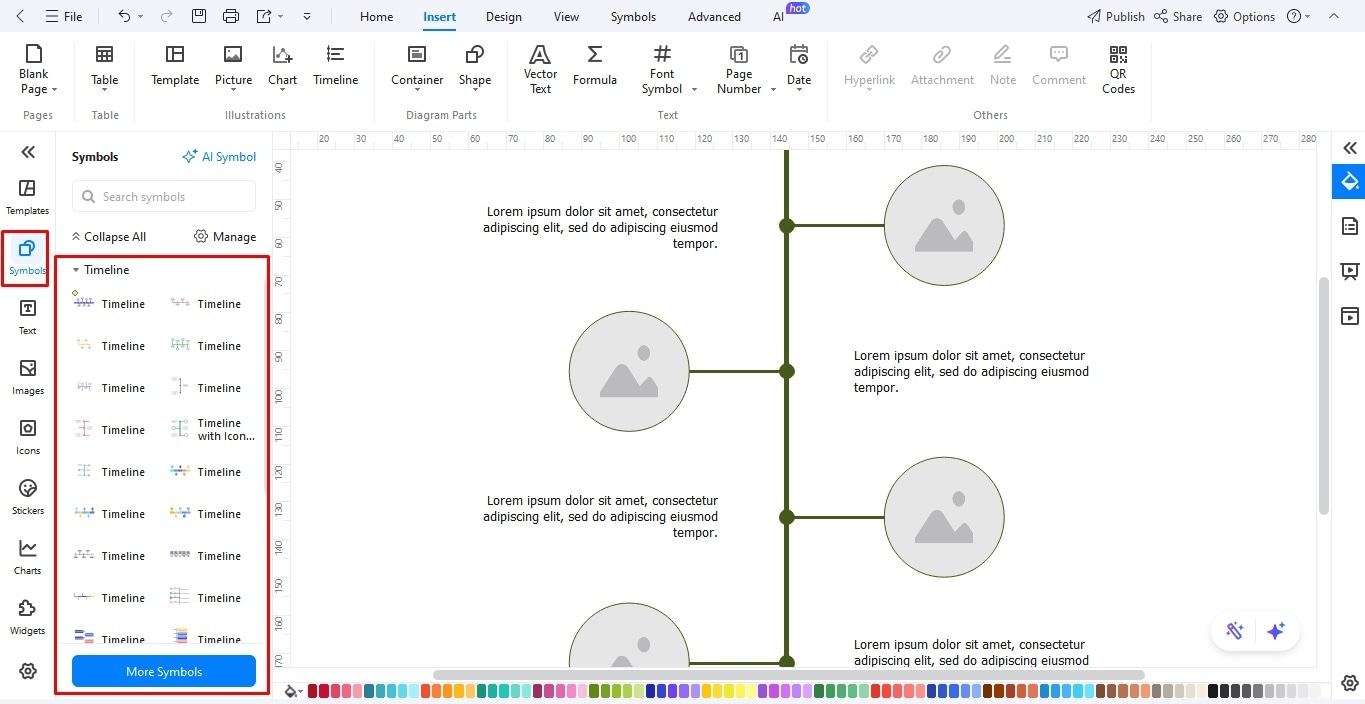
Step3Adjust the Structure
Personalizing this structure to your data’s requirements is equally important. So, select the layout from the canvas and modify the following details.
- Milestone: Decide the number of milestones (6, 7, etc).
- Milestone style: Modify the color and appearance of each milestone in the structure.
- Line direction/style: Adjust the direction (right, left, up, down) and style (color, thickness, etc) of the central timeline line.
- Timeline type: Choose between a horizontal or vertical layout.
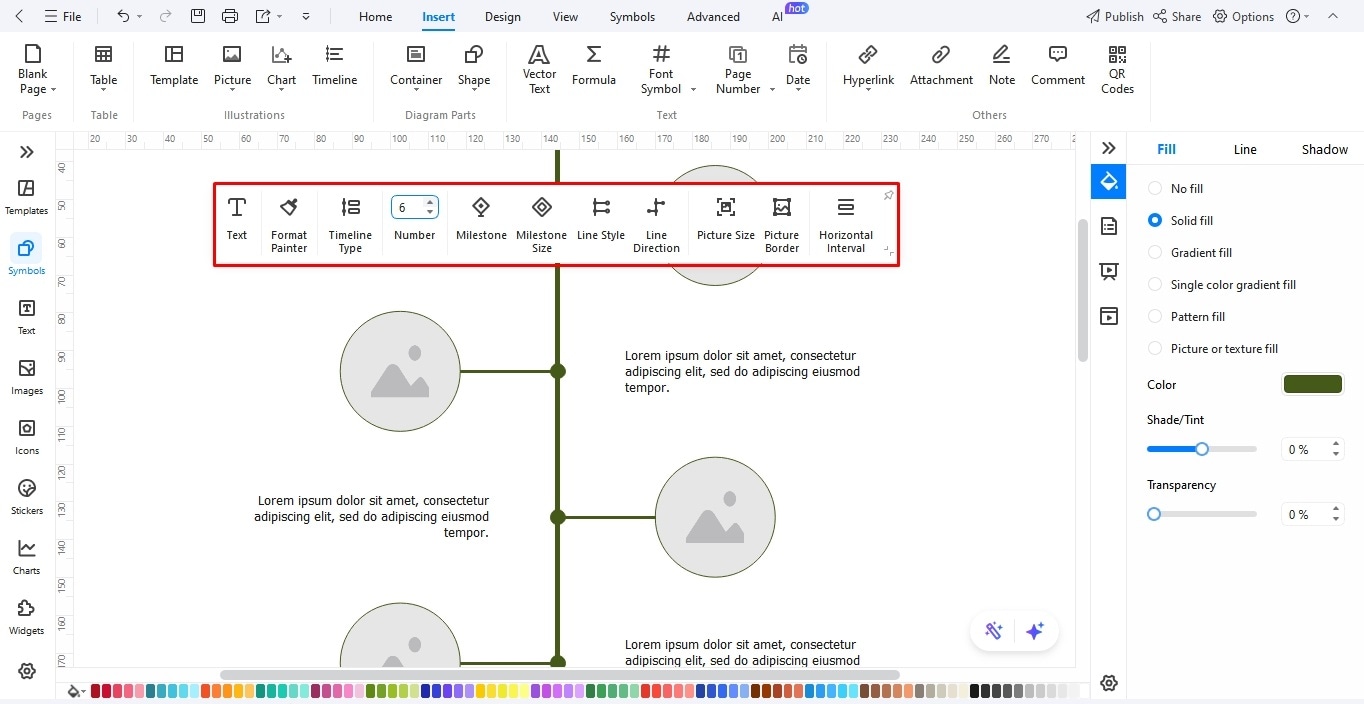
Step4Add Description for Events
Once the basic structure is in place, you can proceed further to add descriptions for these milestones. For this,
- Double-click anywhere on the canvas and start typing.
- Limit your event’s title to certain keywords and don’t make it wordy, as it confuses the reader.
- Repeat this step for the event’s descriptions. However, these descriptions would be a little longer, but would avoid fluff.
- Modify the font size, color, and style from the on-screen prompt or Home tab.
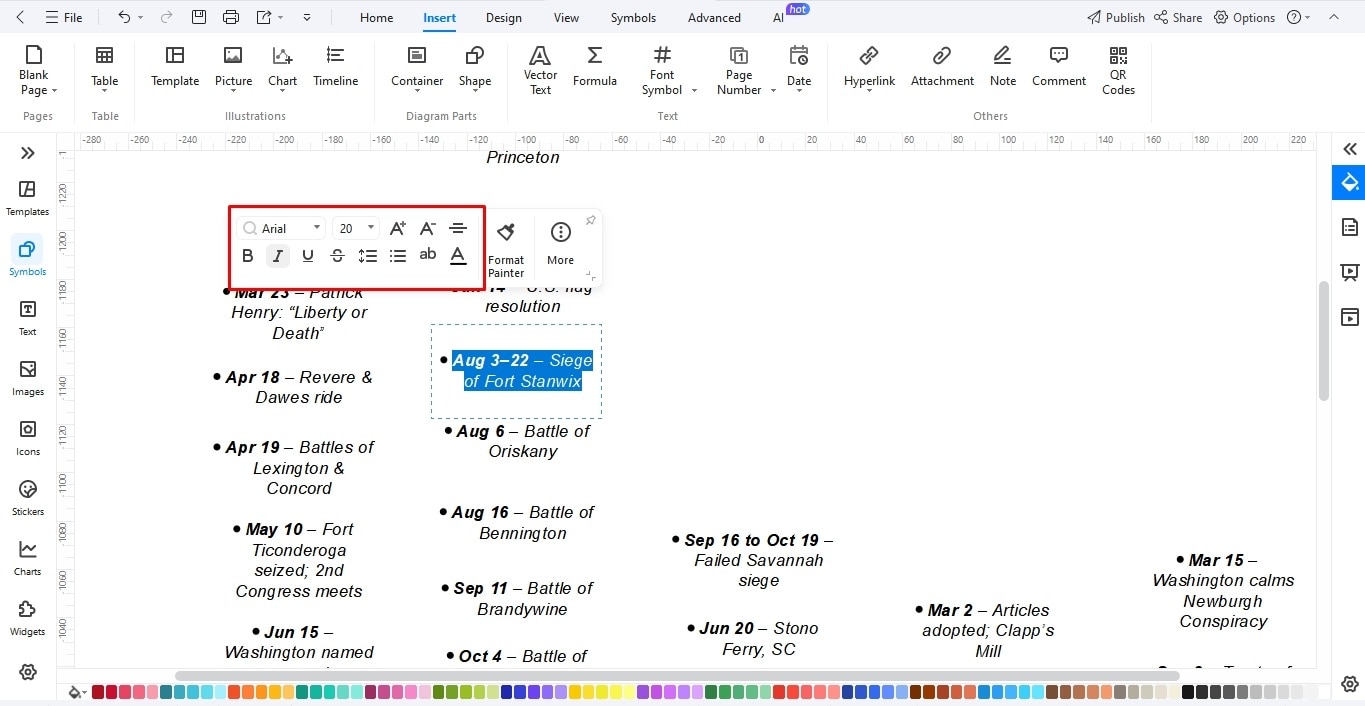
Struggling with keeping your descriptions concise? Try Edraw AI. It employs intelligent algorithms to polish the text, shorten it, translate it, and summarize it. To do this,
- Select text from the canvas and click Edraw AI from the on-screen menu.
- Select your desired operation from the listed menu and let the software handle the rest.
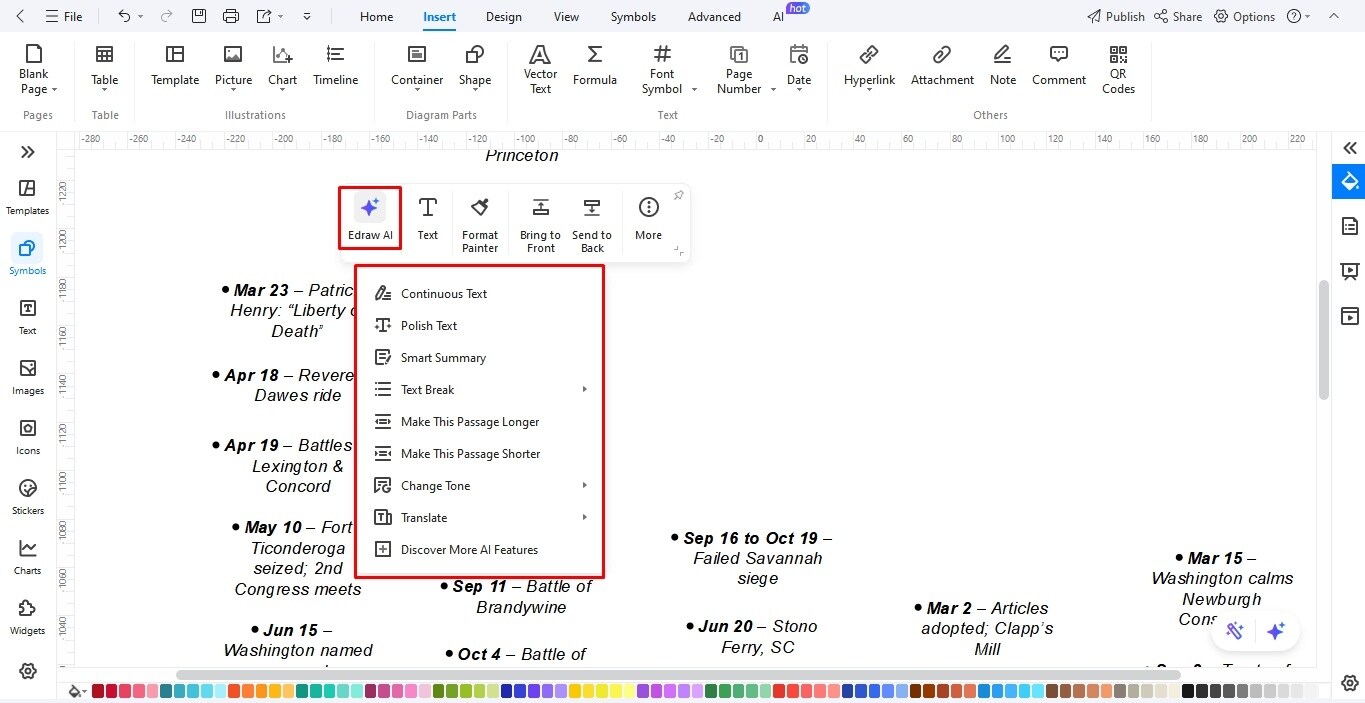
Step5Insert Pictures
Most people stop here; we won’t. The timeline is technically complete, but adding pictures will improve your audience’s understanding of the events. For this,
- Visit the Insert tab at the top and click Pictures.
- Browse the desired images from the device one by one.
- You can change the frame’s shape, thickness, color, etc, and picture’s transparency, contrast, and brightness from the on-screen menu.
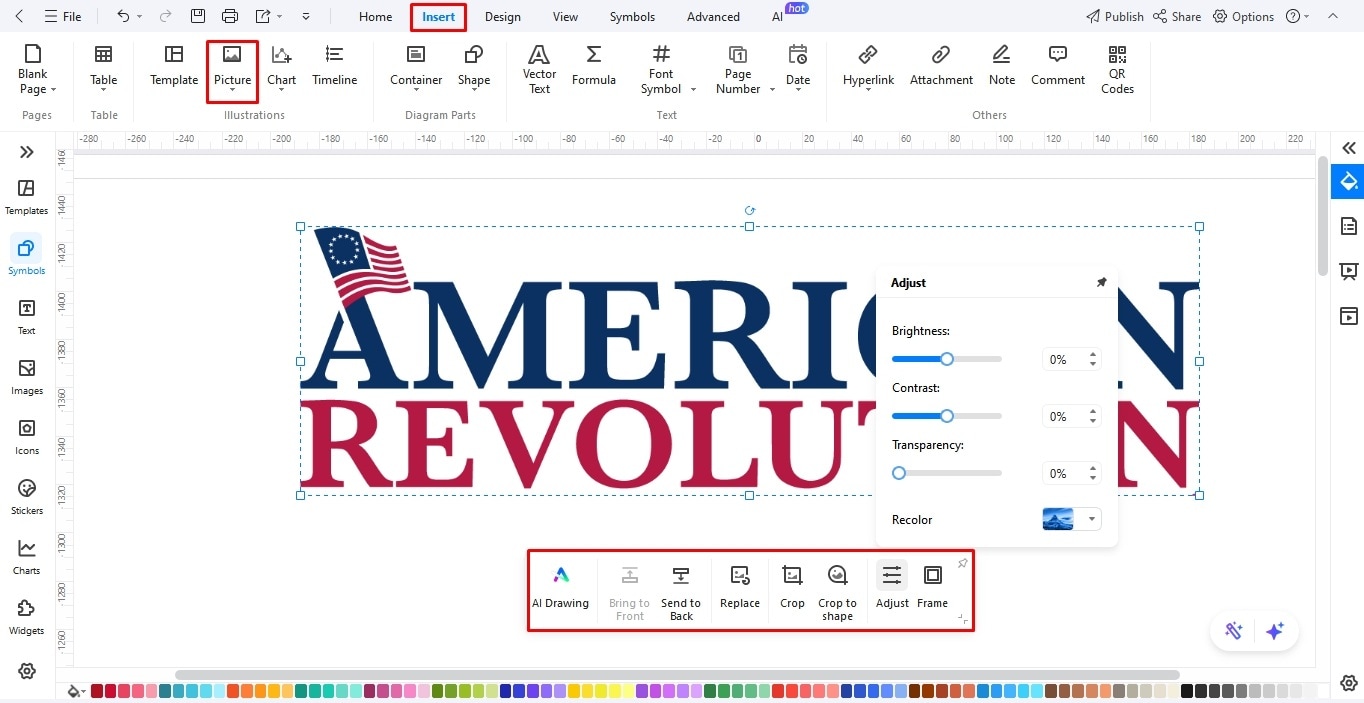
Step6Modify the Design
We’re almost there. A few final design touches, and you are done. To do this,
- Visit the Design tab at the top and change the color scheme, orientation, background, and theme of your diagram.
- Alternatively, you can also set a background image for your diagram. For this, you can browse pictures from the Image library or get them from online sources like we did earlier.
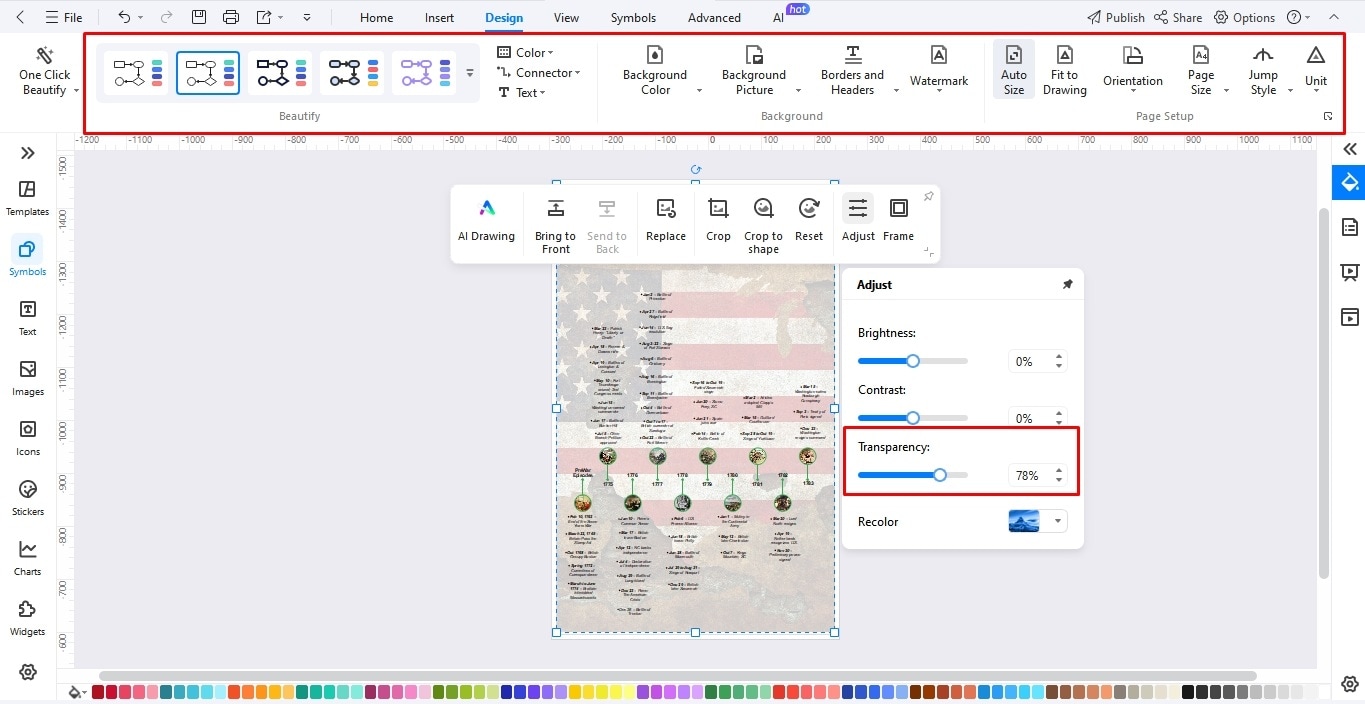
Step7Export and Save!
Satisfied with the outcome? It’s time to download the revolution timeline.
- Go to the File menu from the top.
- Click Save As to download the Eddx. version of your diagram to further modify it later on.
- Or, select Export and choose your desired format. EdrawMax supports over ten formats, including PNG, JPG, JPEG, PDF, MS Office, and more.
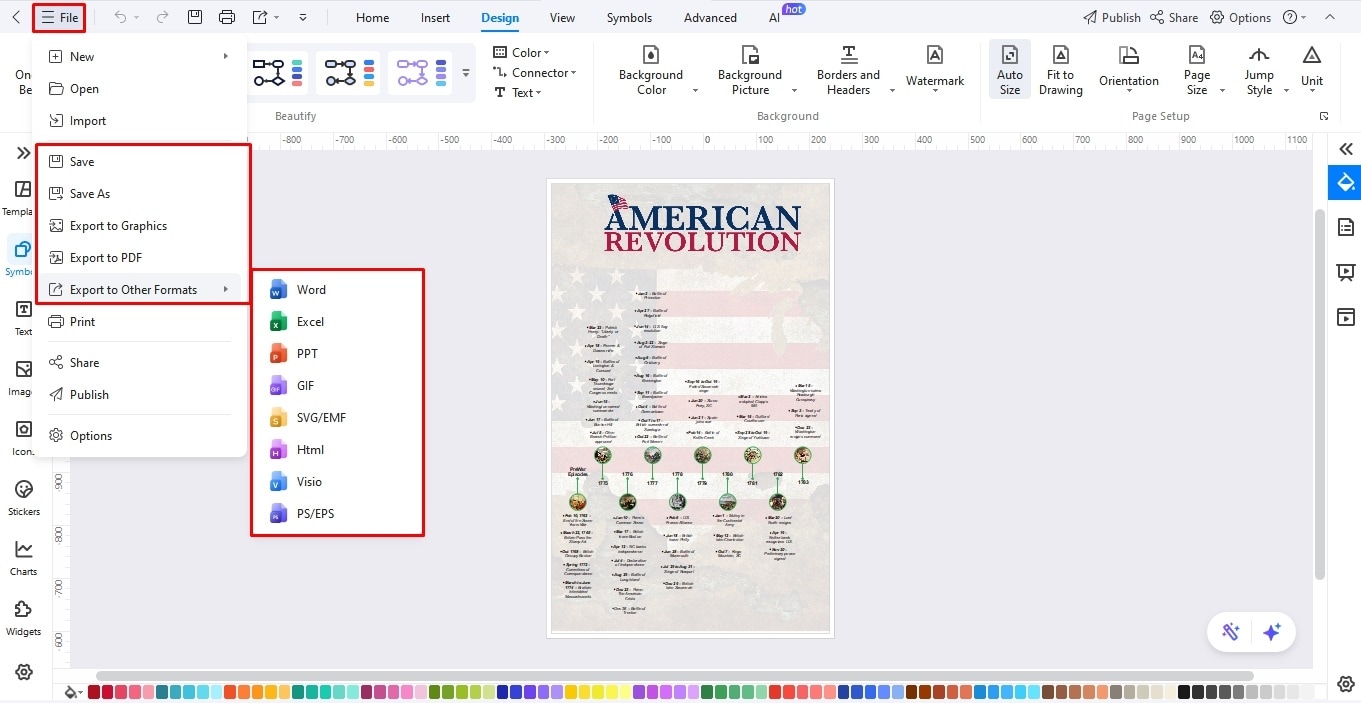
Wrapping Up!
This American Revolutionary War timeline intricately covers the significant events, from discriminatory tax policies, intimidation, and battlefield victories. You can do the same with any other complex historical episode using EdrawMax. Don’t have time to build from scratch? Head over to its template community and explore more similar history timeline examples.




